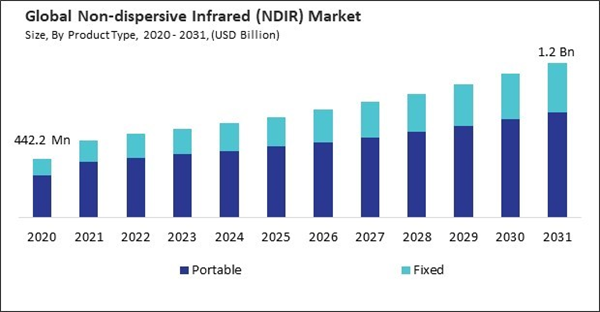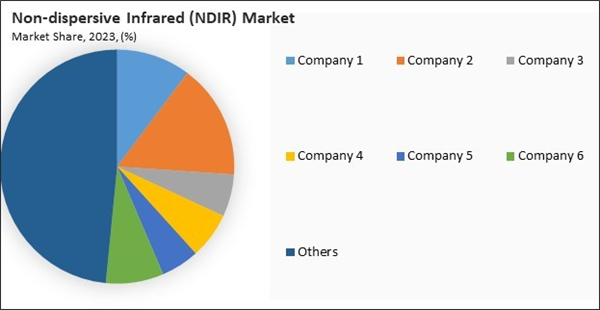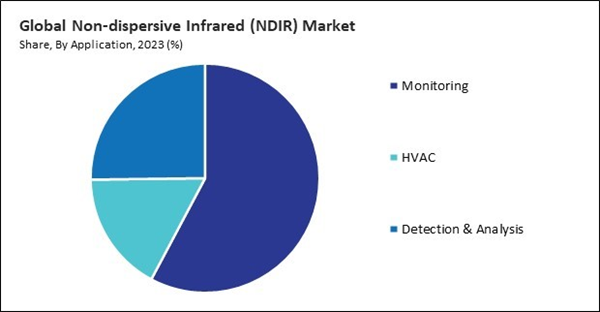The Global Non-dispersive Infrared (NDIR) Market size is expected to reach $1.2 billion by 2031, rising at a market growth of 7.3% CAGR during the forecast period.
Elevated focus on emissions control, the demand for enhanced IAQ in vehicles, and the development of intelligent and connected vehicles are all factors that position the segment for substantial expansion in the coming years. Thus, the automotive and transportation segment acquired $135.0 million revenue in 2023. As technology advances, NDIR sensors are expected to play an increasingly important role in shaping the future of automotive emissions control and air quality monitoring.
NDIR sensors offer a non-invasive and highly accurate method for measuring gases in exhaled breath, providing valuable insights into an individual's health status. Therefore, the emerging applications of NDIR sensors in healthcare are creating growth prospects for the market.
Additionally, ongoing advancements in NDIR sensor technology, such as miniaturization, improved sensitivity, and lower power consumption, are expanding the applications of NDIR sensors in various industries. Thus, the rapid advancements in the field will aid in the expansion of the market.
However, the high initial investment can deter potential customers from adopting NDIR technology. Many businesses, particularly smaller enterprises, may hesitate to invest in NDIR systems due to the significant upfront costs. Thus, the requirement of high initial investment can hurt the market by limiting adoption, slowing market growth, and impacting market competitiveness.
The leading players in the market are competing with diverse innovative offerings to remain competitive in the market. The above illustration shows the percentage of revenue shared by some of the leading companies in the market. The leading players of the market are adopting various strategies in order to cater demand coming from the different industries. The key developmental strategies in the market are Acquisitions, and Partnerships & Collaborations.
Elevated focus on emissions control, the demand for enhanced IAQ in vehicles, and the development of intelligent and connected vehicles are all factors that position the segment for substantial expansion in the coming years. Thus, the automotive and transportation segment acquired $135.0 million revenue in 2023. As technology advances, NDIR sensors are expected to play an increasingly important role in shaping the future of automotive emissions control and air quality monitoring.
NDIR sensors offer a non-invasive and highly accurate method for measuring gases in exhaled breath, providing valuable insights into an individual's health status. Therefore, the emerging applications of NDIR sensors in healthcare are creating growth prospects for the market.
Additionally, ongoing advancements in NDIR sensor technology, such as miniaturization, improved sensitivity, and lower power consumption, are expanding the applications of NDIR sensors in various industries. Thus, the rapid advancements in the field will aid in the expansion of the market.
However, the high initial investment can deter potential customers from adopting NDIR technology. Many businesses, particularly smaller enterprises, may hesitate to invest in NDIR systems due to the significant upfront costs. Thus, the requirement of high initial investment can hurt the market by limiting adoption, slowing market growth, and impacting market competitiveness.
The leading players in the market are competing with diverse innovative offerings to remain competitive in the market. The above illustration shows the percentage of revenue shared by some of the leading companies in the market. The leading players of the market are adopting various strategies in order to cater demand coming from the different industries. The key developmental strategies in the market are Acquisitions, and Partnerships & Collaborations.
By Product Type Analysis
On the basis of product type, the market is classified into fixed and portable. The fixed segment witnessed a remarkable 29% revenue in the market in 2023. Fixed NDIR systems can be easily integrated into existing control systems, allowing for automated responses to gas leaks or hazardous conditions.By Application Analysis
By application, the market is divided into monitoring, HVAC, and detection & analysis. The monitoring segment acquired 58% revenue share in the market in 2023. The increasing use of NDIR technology in monitoring is driven by its high accuracy, reliability, and versatility.By Gas Type Analysis
Based on gas type, the market is characterized into carbon dioxide, hydrocarbons, refrigerant gases, sulfur hexafluoride, carbon monoxide, VOCs, and others. The hydrocarbons segment procured a 21.2% growth in the market in 2023. Environmental and health consequences may result from hydrocarbon emissions, including their contribution to air pollution and climate change.By Vertical Analysis
Based on vertical, the market is segmented into automotive & transportation, chemicals, oil & gas, medical, industrial & manufacturing, environmental, food processing & storage, and others. The food processing & storage segment procured a considerable growth rate in the market in 2023. A rise in consumer preferences and the expansion of global populations have contributed to an intensifying need for processed and packaged food items.By Regional Analysis
Region-wise, the market is analyzed across North America, Europe, Asia Pacific, and LAMEA. The Asia Pacific segment acquired 35.2% revenue share in the market in 2023. The surge in industrialization observed in Southeast Asian countries, including China, India, and others, has resulted in a heightened need for gas sensing and monitoring technologies, such as NDIR.List of Key Companies Profiled
- Honeywell International, Inc.
- Amphenol Corporation
- MSA Safety Incorporated
- Fuji Electric Co., Ltd.
- Yokogawa Electric Corporation
- Emerson Electric Co.
- Horiba Ltd.
- Siemens AG
- Sick AG
- Senseair AB (Asahi Kasei Corporation)
Market Report Segmentation
By Product Type- Portable
- Fixed
- Monitoring
- HVAC
- Detection & Analysis
- Carbon Dioxide
- Hydrocarbons
- Refrigerant Gases
- Sulfur Hexafluoride
- VOCs
- Carbon Monoxide
- Others
- Industrial & Manufacturing
- Medical
- Environmental
- Chemicals
- Oil & Gas
- Food Processing & Storage
- Automotive & Transportation
- Others
- North America
- US
- Canada
- Mexico
- Rest of North America
- Europe
- Germany
- UK
- France
- Russia
- Spain
- Italy
- Rest of Europe
- Asia Pacific
- China
- Japan
- India
- South Korea
- Australia
- Malaysia
- Rest of Asia Pacific
- LAMEA
- Brazil
- Argentina
- UAE
- Saudi Arabia
- South Africa
- Nigeria
- Rest of LAMEA
Table of Contents
Chapter 1. Market Scope & Methodology
Chapter 2. Market at a Glance
Chapter 3. Market Overview
Chapter 4. Competition Analysis - Global
Chapter 5. Global Non-dispersive Infrared (NDIR) Market by Product Type
Chapter 6. Global Non-dispersive Infrared (NDIR) Market by Application
Chapter 7. Global Non-dispersive Infrared (NDIR) Market by Gas Type
Chapter 8. Global Non-dispersive Infrared (NDIR) Market by Vertical
Chapter 9. Global Non-dispersive Infrared (NDIR) Market by Region
Chapter 10. Company Profiles
Companies Mentioned
- Honeywell International, Inc.
- Amphenol Corporation
- MSA Safety Incorporated
- Fuji Electric Co., Ltd.
- Yokogawa Electric Corporation
- Emerson Electric Co.
- Horiba Ltd.
- Siemens AG
- Sick AG
- Senseair AB (Asahi Kasei Corporation)
Methodology

LOADING...











